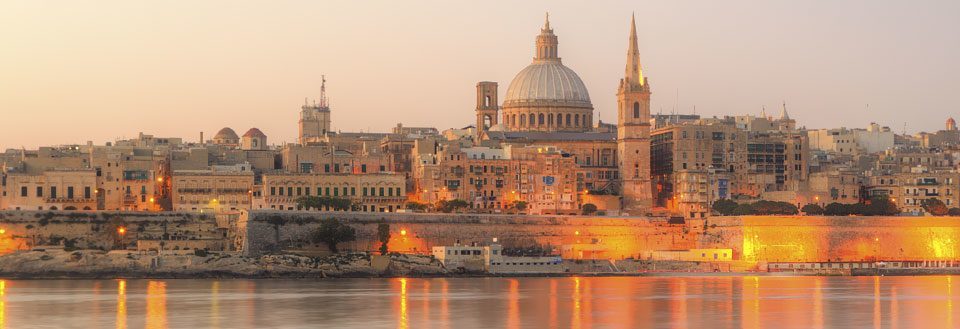
The Ggantijia-temples are some of the most important archaeological discoveries of the Maltese past. They were built around 3600 B.C. and have a very complex structure for that period.
Ghar Dalam is situated by the city of Birzebbuga, on the southern coast of Malta. This cave is the earliest sign of human- and animal life on Malta, containing an important collection of fossils. Here, you can see skeletons of extinct species, such as dwarf elephants and hippopotamuses.
These two temples are situated near the village of Qrendi, 15 Km from Valletta. The temples date back from the Stone Ages, and are placed only 500 meters apart from each other. At the archaeological excavations they have found gigantic stone plates, reliefs and oracle chambers.
30 soldiers used to be stationed at St. Maria's Battery, in order to protect the island against pirates. It was built in 1702 and is the most expensive tower in Malta. Today, the tower is used to search for smugglers.
The Art Museum is situated in a palace from the 1700s and contains paintings, sculptures and furniture form the time of the Knights of the Order of St. John. There are artworks of Domenico di Michelino, Carpaccio, Perugino, Tintoretto, Rivera, etc. There is also a section exclusively reserved for Maltese artists.
100 meters East of Comino, there is a small, uninhabited island called Cominotto. The water between the two islands is a popular place known as the Blue Lagoon.
The Citadel is situated in the main city of Gozo - Victoria. The 'Gran Castello' (as the locals call it) is an old fortified city, with an intricate network of narrow streets designed to confuse the enemy. It also has an impressive Cathedral.
The Palace is situated on Republic Street in Valletta. It was originally home to the Grand Master, later to the English Governor, and today it houses the Presidency of Malta. The Palace contains two beautiful yards, a fine museum and one of the most impressive collections of tapestry in Europe.
The Manoel theatre opened on January 9th 1732, making it one of the oldest functioning theatres in the world. The renowned Portuguese Grand Master Manoel de Vilhena with the purpose of distracting the population built it.
This church is situated near the cities of Gharb and Gammar. Because of the detailed craftwork, it stands as one of the most important churches in Malta. The Church of the Pilgrim's has a 50 meters high tower, and was blessed by His Holiness Pope Pius XI in 1932.
There are only 4000 inhabitants in the towns of Vittoriosa, Senglea and Cospicua taken together. However, they have as many interesting sights as Valletta and Mdina. They play an important part in the history of Malta, but are not as visited as they should be.
From the Upper Barracca Gardens you have a splendid view of Valletta's Grand Harbour and the old town of Vittoriosa. The park also contains an important collection of statues and memorials of important Maltese citizens.
The so-called 'festas' are held every weekend during the summer. Each village has its own 'festa', celebrating the local Saint with a blast of a party. Processions of locals dressed up as characters from the Bible, with statues on their shoulders walk, through the decorated streets. The feasts end with a wonderful display of fireworks, which is believed to keep evil spirits away.
The first Cathedral of Malta was built by Lorenzo Gafa in 1702. It is onsidered one of the best examples of Maltese Baroque architecture.
When entering Mdina through the main gate, you pass the Mdina Dungeons, which are an old prison. The small cells offer proof of the methods of torture used there until 1813.
This building is thought to be the oldest in Malta. The year 1388 is inscribed on one of the pillars.
Sliema, with the neighbouring town of St. Julian's and St. George's, are Malta's biggest and most modern city. It has an important residential area and a fine beach resort. On the 3 Km beach promenade there are more people than anywhere else on the island. It has an important shopping centre with cafés and restaurants. There are also many hotels in Sliema, as well as nightclubs and a casino.
This Cathedral used to be the Church of the Knights of the Order of St. John of Jerusalem, and is thus dedicated to John the Baptist. The Cathedral was built from 1573 to 1577 by Gerolamo Cassar (1520-1586), who was the constructor of the Order. The Cathedral Contains Carvaggio's masterpiece "The Beheading of John the Baptist". Both historically and artistically the Cathedral is one of the most important attractions on the island.
The Art Museum is situated in a palace from the 1700s and contains paintings, sculptures and furniture form the time of the Knights of the Order of St. John. There are artworks of Domenico di Michelino, Carpaccio, Perugino, Tintoretto, Rivera, etc. There is also a section exclusively reserved for Maltese artists.
The National Museum in Auberge de Province (which used to be the district of the Knights of the Order of St. John) exhibits an important collection of Maltese archaeology, history and artwork, such as artefacts dating back to Roman and Punic times.